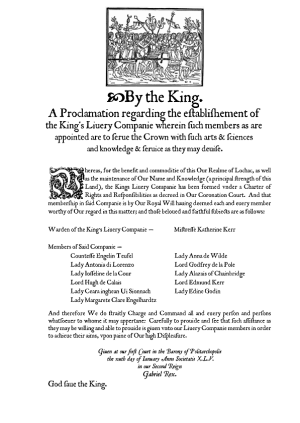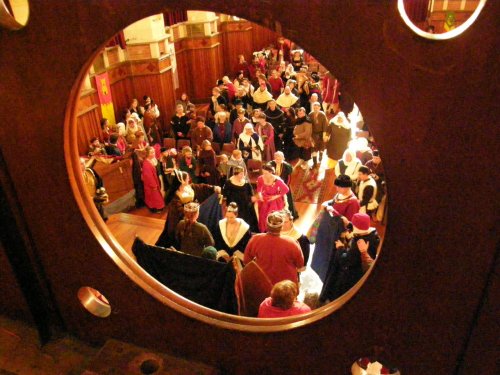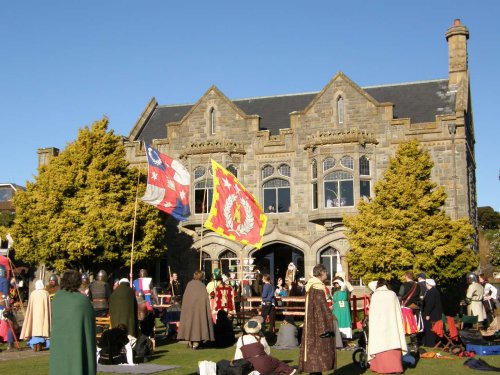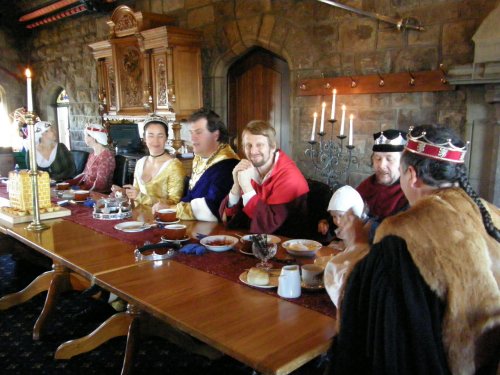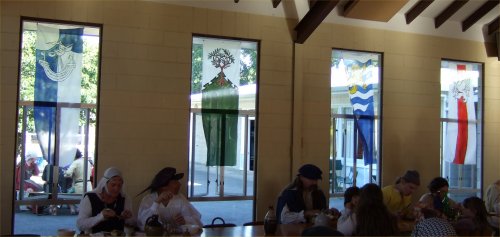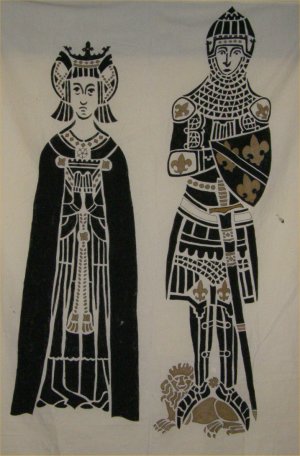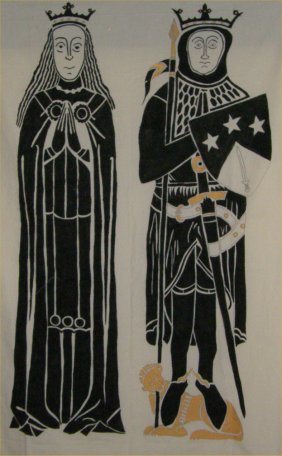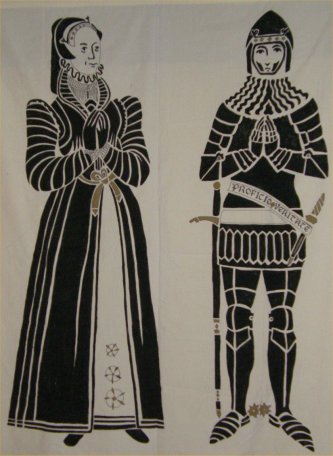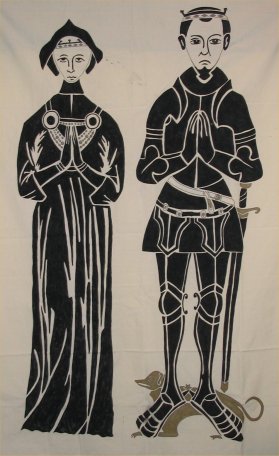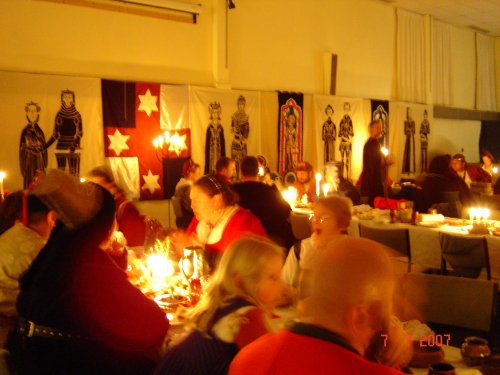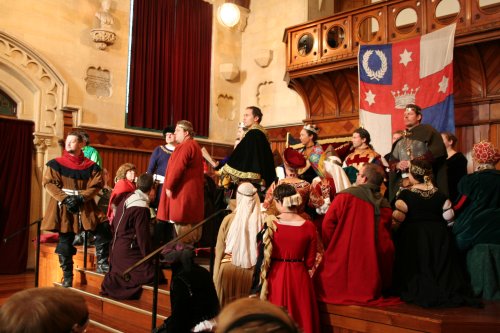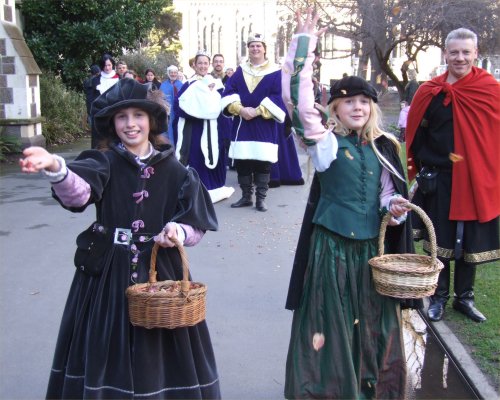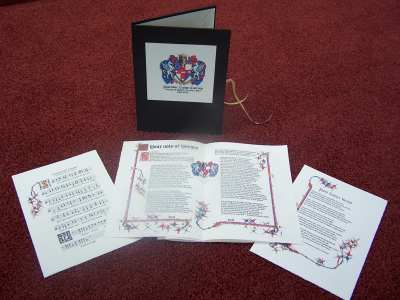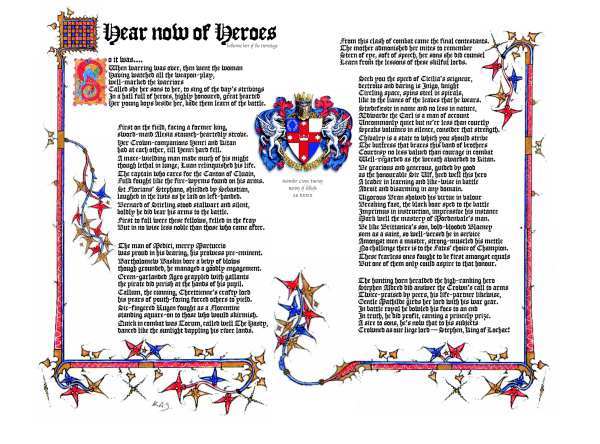 |
|
Crown Activities[Crown - A Rat and a Cat Consort][Livery Companie] [November Crown Tourney ASXLIV] [May Crown ASXLIII] [Midwinter Coronation ASXLII] [Paens] [Banking As an Organised Pursuit] Since the Crescent Islands joined the Kingdom of Lochac, back in AS38 or thereabouts, we have had the privilege of joining in -- sometimes even running -- Crown events, the tournaments and coronations that honour our Kings and Queens. They have generally been special occasions, even more so when you get to have some stake in the game by participating, in whatever form. My lord-husband Bartholomew Baskin took to the field in a number of Crown Tournaments, most notably remembered as the only fighter to leg then-soon-to-be King Siridean at the Darton May Crown; age or wisdom have seen him since retire from fighting. More recently I have been consort to Sir Radbot von Borg, which has proved most entertaining -- the related adventures and activities are recounted here. His Majesty's Livery CompanieHis Majesty Gabriel de Beaumont, at his first Coronation, established a group of people from across the Kingdom charged to undertake some project to stretch themselves, learn and/or provide a service. It's one of the few times I have ever felt truly envious, as I watched them become His Majesty's Liverymen, headed by Countess Bethan of Brockwood. What a company to belong to! So I was startled, humbled and greatly honoured to be asked to head His Majesty's Liverymen when Gabriel next took the throne in AS45. Bethan had been Sheriff; to avoid the obvious jokes, I asked if I could be Warden, and thus it was so. One of my first tasks was to develop a suitable proclamation and charter for the Companie, a task which fit well with my predeliction for late-period printing and communications. I'd come across a great resource Printed Ephemera: The Changing Uses of Type and Letterforms in English and American Printing, by John Noel Claude Lewis (Cowell 1962), while browsing in the Auckland Museum library. It had a proclamation by the King which provided a great model for a public announcement (although I figured out later that the 1570 date was out by a century; fortunately some of James I's proclamations followed a very similar layout much closer to our current cut-off date). ProclamationI set the proclamation to match the model, with a nice woodcut of flocking populace from the rather dodgy Hypnerotomachia Poliphili. The text was Elizabethanish and typeset in the ever-useful JSL Ancient font with the conversions allowing long esses and ligatures. For the typeset version, here's the A4 PDF; here is the text used:
The proclamation was read out in Coronation Court and each of the liverymen was given a copy to take away. Livery Companie CharterHow can you have a Livery Companie without a founding charter? I had fun cobbling one together based on various bits from various university and livery company charters from the 1300-1500s. And Richard III provided some useful clauses out of his founding charter for Middleham College, specially the final paragraph which basically says His Majesty can do what he likes with the Charter's Terms & Conditions. Who said fine print was a modern concept?!
We ran out of time to give it to a scribe (or possibly didn't have enough in the Treasury to bribe one sufficiently!). I typeset this onto A3 in a suitable manuscript font with a large Cadel strapwork G to start off with. The Provost had it printed so there would be something at Coronation for the Companie members to sign. Livery Companie Lunch InviteWhen we had a batch of Livery Companie members at Canterbury Faire, I invited them to a shared lunch, using as a model a Trinity House Order to Attend. The latter was a rather preremptory prepped card with a demand from the Master and Warden for watermen to attend the house at a set time in the morning: You are hereby Required to make your personal appearance before the Master and Warden of this Corporation, at their said House in Water-lane near the Custome house on [insert day here] the [date] of [month] between Ten and Eleven in the Forenoon, hereof you are not to fail. By Order. My wording was a little more polite. We had a great lunch, a nice chance to get to know each other and for people to talk about the very diverse projects they had each undertaken as part of the Companie activities. May Crown ASXLIII: A Heir, an Heir, My Kingdom for an Heir!I was asked to provide entertainment for May Crown in Darton. Their Majesties Berenger and Bethan had had a running story, not to mention a number of battles, regarding the need for an heir - His Majesty had demanded of Her Majesty to provide one with three month's notice! That seemed likely to provide a suitable theme for the event which would see Their heir finally make an appearance. I put together a suitable cast to go with Shakespeare's Seven Ages of Man - a nurse carrying an infant through to a doddery old fellow "sans everything" (beautifully played by Master Christopher Foxe). There was no space for staging in the hall as it was jam-packed, so I lined everyone up by the door and had them come in as I recited their section. (The lovely young lad Eric Braythwayte was justifiably startled to get halfway down the aisle and hear himself described as a "whining schoolboy".) His Highness Siridean, having won Crown Tourney that day, agreed to stand in as "the soldier". Thus when Their Majesties inspected the possible choice of heirs, they were able to pick someone suitably martial out of the line-up. It was fairly simple as far as staging goes, but reasonably effective. Later I presented a subtelty based on another search for an heir - the Sword in the Stone story. I had prepped a poem to go with it, but canned that, as the night was moving on and the setting not conducive. The subtelty itself was a faux rock with a large dagger sticking out of it, surrounded by smaller "stones" of sugared almonds. His Highness prevailed in extracting the dagger, thereby proving he was the undoubted heir to the Throne. Midwinter Coronation ASXLII[Ordo] [Baronial Banners] [Kings Wall] [Ceremonial Aspects] [Firey Entertainment] [Kingdom Map] Midwinter Coronation ASLXII was a truly mammoth task, spear-headed by my Lord Bartholomew Baskin and me as Co-Stewards for the first Crown Event to be held in Southron Gaard's 25-year history. It involved a huge number of projects and activities, all designed to showcase the skills of our populace in as high-end an event as we could possibly manage. A vast amount of work was put in by many, many people, most of which we managed to document on a DVD that was made of the event. The material below covers the main actitivites and projects I undertook during the 18-month planning and preparation period -- there were lists, lots and lots of lists..... There was a lot to this event. In three days we used the following venues:
We made the best use we could of our city's Gothic architecture, choosing venues that would lend themselves to the occasion with minimal work, but decoration and transportation were two major areas requiring considerable planning. The logistics involved were complicated, but extensive forethought and a lot of briefing of the most excellent event crew and populace meant virtually everything went off witout a hitch. Even the greatest imponderable -- the weather -- played along with very cold, but crisp clear weather (mind you, just to demonstrate how carefully we'd planned, we'd checked the weather reports for those dates for the previous six years, so were reasonably confident of a dry spell!).
OrdoCORONATION ORDO Technically, an ordo (pl. ordine) is an order of service, a script if you will, of how important rituals should be carried out, such as coronations, royal funerals and the like. They collate the hymns, prayers and ceremonies used during such ceremonies and, in some cases, served to legitimate the process by ensuring that people understood the connections to the past and the rights and rituals of royalty that were involved. Well-known ordine such as the general ceremonial work of the English Liber Regalis or the more specific Coronation Book of Charles V of France were used as guides for what should be done, when and by whom at such events, complete with copius illuminations or woodcuts to illustrate the point. The Midwinter Coronation Ordo was more along the lines of a souvenir booklet of the kind that were produced from time to time for events such as major festivals, formal tournaments and other public occasions. That said, the Charles V Ordo was very much a commemorative work, with the Emperor intending that it be used to emphasise the continuity of the dynasty in the person of a specific king and a specific event (Lacey). In its commentary on the Coronation Book of Charles V, commissioned by the king to commemorate and certify his coronation on 19 May 1365, the British Library notes that: In an age before television or even newspapers, this manuscript provided a permanent record of the rituals used on a specific day, at a specific place, and involving specific people. The front cover of the Midwinter Coronation Ordo has a woodcut of the Coronation of Henry VII and Catherine of Aragon on June 24, 1509; note the Tudor rose and pomegranate symbols above their heads (Cambridge University Library). Many ordo contained significant numbers of illustrations showing what would go on at a Coronation. This ordo has just the one relevant picture, but it follows the tradition of such ordo as the Litlyngton Missal and the Pamplona Coronation Order of ensuring that the "king-in-majesty" has prime position, rather than the bishops or lay peers (Lacey) Page 1 of the Midwinter Coronation Ordo contains the Prologue, a highly edited version of the Saga of Lochac, introducing the Crowns of the Kingdom, written by Giles Leabrook. We used this as an introduction to the Final Court of Their Majesties Alfar and Gudrun, as it tied in nicely with the Norse period of Their Majesties and provided a fitting way to introduce/reinforce the history of the Kingdom. It also has a tangential reference to the use of the Royal brass rubbings in the Feast Hall along the King's Wall. Ordine would typically cover the timing of events, announcing in what order various aspects of the ceremony should come. We used a perioid style of commentary to provide a useful schedule indicating what was happening where. Given the multiple venues and activities, the reminders were necessary. The map of the walk from the Great Hall to the Feast Hall and back was produced by Mistress Roheisa le Sarjent. The aim was to make it clear which paths to take through the gardens and the fact that the return evening route differed from the earlier daylight one. The depiction of Christchurch Hospital as a Hospitaller base is a particularly nice touch. The remainder of the ordo consisted of a mix of reminders, pertinent information and factoids to help fill the 8-page booklet, such as this: COURTESIES, an you be so Kind. Then followed a short notice reminding folk how to show respect to the Royal Presence and a list of how to address Persons of Rank and Title. The latter can be a concern for new people -- and Southron Gaard had had an influx -- so this worked in well with the common period practice of event organisers noting in their broadsheets the names and titles of those who had attended their event (an early form of "A" list!). Prince Hugh had asked for cloven lemons to be provided at the Ball. Bearing in mind that there are different practices with regard to these -- and that some places have not seen them for a long time -- we included the local "rules": CLOV'D LEMONS. Then came a section briefly covering the story of Saint Willibald, on whose Feast Day the Coronation was to be celebrated. Given the importance of saints and saints days in period, and the fact that St Willibald himself was Royal, this seemed an appropriate inclusion. The final page had the Latin and translation of Lochac Praeclarus Est, the Coronation anthem used during the procession of the Royal Heirs. We thought that this would help the populace understand what was being sung by the Southern Swans and why. The original score had been written by Master Crispin Sexi in AS37 for King Alfar and Queen Elspeth, with words by Crispin and Master Daffyd of the Glens. This version was arranged by Scotaidh mac Uilliam, to the Gloria from Missa Pange Lingua by the 14th-century Franco-Flemish composer Josquin des Prez. The words were modified to fit the music, and some changes made (the original "in servitio" was changed on the advice of Ignatius of Castelburn, to "in officio", to shift the meaning from slavery to service). Hedeman notes that independent coronation books were made after the ceremony for a small, private audience. In some cases, it appears that these were commissioned to deliberately draw attention to the sponsor of the work, with Jeanne d'Evreux's Ordo ad Consecrandum containing what appear to be the coat of arms of the work's patroness linked with that of the queen throughout -- such is not the case here! The text was typeset electronically, primarily using Jeff Lee's Ancient and JSL Blackletter fonts, based on the transitional typefaces used by English printers Edward Jones and J. Redmayne in the latter part of the 1600s. While technically outside the SCA period, Lee's fonts are very close in style to period typefaces used by printers throughout Europe. The paper used was laid, cotton-based, 100gsm cream Conqueror, folded to produce an octavo (roughly A6). It is a reasonable approximation of the type of paper in common use for printing in later period, described by Middleton as of linen or cotton rag content with a yellowish tint and well sized (pg 3). The Ordo was bound using a standard three-hole pamphlet stitch. Midwinter Coronation Ordo: A4 PDF. It should be printed double-sided and folded in half, then in half again to produce an eight-page booklet. Baronial BannersThe baronial banners were begun partially in response to the baronial regalia project sponsored by Duchess Yolande. The idea was to produce a set of banners with stylized arms for each barony in the kingdom, utilising their colours and main charges. The designs were initially mapped out by me and developed far more artistically by Mistress Roheisa le Sarjent. While I had the Midwinter Coronation in the back of my mind -- the alcoves in the Great Hall were an obvious place for such hangings -- I also thought that the shape of the long banners would make them useful for positioning in the windows of the feast hall at Canterbury Faire for a stained glass effect, and they got their first use at the Faire that year.
Kings' WallOnce the Baronial banners were done, the next project was to produce a set of memorial brasses -- these hangings were intended to help provide wall cover in the otherwise mundane Coronation Feast Hall. (We had tried desperately to see if we could get a deal to use the glorious architecture of Christ's College Dining Hall but, despite having references from a number of Old Boys, it was not a goer due to a commercial kitchen contract they had.) Brass rubbings, primarily of the 13-14th centuries, were sourced and adapted to produce a set of images identifiable as stylised versions of each Royal couple. I put many of these together, agains with Mistress Roheisa le Sarjent helping with some of the design, and we used an OHP to transfer the design from transparency to the wool ground (selected as it was the cheapest suitable material available at the time).
The designs were then outlined with marker pen and filled in with fabric paint to produce a set of "rubbings". Some common motifs were used, such as the crowns that each wears, white roses, animals lying at the feet of the Dukes. Individual identifiers included personal heraldry, individual garb (such as the Elizabethan of Queen Mathilde and the "proficio veritate" wording on the hem of King Stephen's tunic), jewellery styles etc. My children complained about how grumpy everyone looked, but of course, they are dead, and that would make anyone look grumpy! Because of multiple reigns, six images were produced in total to represent all the previous reigns in order. I did almost all the painting involved, except for the hanging of King Alaric and Queen Nerissa which was undertaken by Lord Oswyn Carolus. The hangings were interspersed with gold striped fabric -- I'd scored a roll of 25m for $25 -- and centered on a Lochac populace hanging, with the glorious appliqued stained glass panals made by Southron Gaard as a gift for the Kingdom of Lochac.
Ceremonial AspectsI had researched a lot of ideas associated with Coronations, from Viking through to Elizabeth's ceremony and beyond. We knew we wanted to have something that was highly formal and, as much as we could, full of the pomp and ceremony that was associated with Coronations, while still having the SCA flavour and honouring its own traditions. Bartholomew and I journeyed to Novermber Crown Tourney in far-off Politarchopolis with the hope of being able to have a word with the victors. As it happened, we had a 15-page checklist (did I mention there were lots of lists?) and Their Majesties Alfar and Gudrun and Their newly acclaimed Highnesses Hugh and Therasa were kind enough to grant us a two-hour meeting to run through the ideas. I think they chose everything.... Final Court and Longship We the people from Rossholm on the other side of the great sea are in a manner of no country or kingdom, dwelling as we do in far southern parts as yet unvisited by any King. Know that we are the descendants of a great Scot who braved the waters with other men from the icy wastes of the far north in the heroic age of our forefathers.In times past, certain Nobles of yours have come across the sea to us to bring us word of the might of the land of Lochac, and we have looked at times to your southernmost Barony for aid and protection. The name, and the references to Rossholm (Ross Island), the great Scot (as in Robert Falcon) and the Heroic Age (of exploration) are all, of course, references to Antarctica and the long-standing claims that Southron Gaard has to guardianship of those lands. The message itself was loosely based on text from the Heimskringla or The Chronicle of the Kings of Norway (Hakon the Good's Saga), in which Chapter 14 deals with the request of the Jamtaland people for Hakon to rule over them: The Jamtaland people, again, were in a manner between the two countries; and nobody cared about them, until Hakon entered into friendly intercourse with Jamtaland, and made friends of the more powerful people. Then they resorted to him, and promised him obedience and payment of taxes, and became his subjects; for they saw nothing but what was good in him.
King Alfar had expressed a strong desire for a longship to be used in the ceremony somehow, in recognition of his Norse roots. We thought long and hard about this, wondering how to incorporate such a motif. The first idea was to have a shadow play, with a silhouette of a longship shown leaving the shadowy shores of the world and sailing off into the distance. Perhaps red cellophane could be used to simulate flames. But His Majesty liked the idea of a life-sized vessel….so we organised a mini-longship which was pulled from the hall after the Duchy ceremony by none other than Aegir (the Norse version of Neptune) followed by a Valkyrie (Lady Mathilda de Villiers) utilising her superb soprano to sing the Anglo-Saxon-style lament for Theodred from Peter Jackson's Lord of the Rings, itself referencing Beowulf. The Kingdom Oil We're all familiar with the term "the anointed king", which recognises the special position given to the royal head of state following their anointing with the holy chrism. In England, the King would be dressed in a special coronation shirt to facilitate his anointing in, typically, five places: on the hands, within the breast, between the shoulders, in the break of the arm (the elbow) and on the head and forehead. Excess oil would be wiped with a linen cloth and this was then used to bind the king's head for seven days, after which the Pelion would be removed and His Majesty would have his hair washed by the Abbot. Roger of Hoveden describes how Richard I was anointed in three places: "on his head, breast, and arms, which signifies glory, valour, and knowledge". I thought hard about finding a way to incorporate this into the Midwinter Coronation ceremony without tripping on the SCA's aversion to religious overtones, and came up with the concept of the Kingdom Oil. Thus began the long quest to gain samples of olive oil from every Barony in the Kingdom. At every event we went to for the space of a year, we sought oil from that region, and the landed Barons and Baronesses obliged. The aim was to mix roughly equal amounts of oil from every barony. Then came more magic -- what about adding something extra-special? We knew of the tradition of SCAdians making pilgrimages to the grounds of the First Tourney in Berkeley to collect a small phial of the dirt from there, and wondered how to get some. And then someone mentioned that Sir Agro had such a phial…. So a tiny pinch of dust went into the mix, and the oil was decanted into in a lovely glass bottle painted with the populace badge by Meisterin Christian Baier and Lady Isabel Maria del Aguila.
At Coronation, the oil was presented by two of my children, Lord Pippin Baskin and Grace Kerr. Lord Pippin poured the oil carefully into a replica of the British Royal Anointing Spoon -- it was a souvenir from the 1953 Coronation of Elizabeth II and models the 12th-century piece of British regalia, allegedly the only piece to have survived the various vicissitudes that have seen all other regalia of an earlier age lost. The spoon had come up on the TradeMe website the week before Coronation and the seller was astonished to learn what we wanted it for….(he even posted the spoon to us before payment was confirmed, as a quick look at our extensive Coronation Website had him convinced this was too complex to be a hoax purchase!). Grace held the spoon and had underneath it a napkin stamped with a Crown and the Southron Gaard tower, to catch any possible wayward drips as Their Majesties carefully touched the oil to their palms. The action was accompanied by the following words, written by me and spoken by HE Bartholomew Baskin: Your Majesties, we ask you to accept this oil, collected from all the Baronies throughout Your Kingdom and containing dust from the ground of the Society's First Tourney field, gifted by Sir Agro Agwesi. Consider from whence this oil has come and hold its warmth between your palms. So may you always feel the warmth of the affection and respect in which the people of Your Kingdom hold the Crown. This was then followed by presentation of two cups by Christopher of Southron Gaard and Lady Rosetta Elizabetta Cortez, with the wish that Their Majesties drink deep of happiness during their reign. Their Majesties did so and, in an inspired additional touch, upended their cups. The Peer Quest King: Pelicans of the Realm. You are the backbone of our great society. Your knowledge and skills and your willingness to serve are what make Our Kingdom run the more smoothly. We charge you with a quest, to go forth and find those who would serve and teach them your skills. Now rise and face the populace. People of Lochac, before you stand the Pelicans of the Kingdom. 'Tis by the unselfish service of the populace that Our Kingdom runs. Those of you who wish to serve, We charge you to seek these gentles out and learn their skills. Queen: Laurels of the Realm. We charge you with a quest to impart your respective arts and talents to any aspiring artisan in Our Kingdom. Now rise and face the populace. People of Lochac, before you stands the pinnacle of artistic achievement of this Kingdom. We charge each of you to seek these gentles out and learn from them, that the beauty and learning of Our Kingdom shall be enhanced. King: Knights of Lochac. We charge you with a quest. Go forth amongst the young warriors of Lochac, working with and training as many as you can. Share your knowledge of chivalric virtues and values as you share your skills in the arts martial. Now stand and face the people of Lochac. Combatants of Lochac, before you stands the flower of chivalry of this Kingdom. We charge each of you to seek them out and learn from them, that the prowess of this Kingdom shall be enhanced.
The actual terms of the quest are not significantly different to those in the Fealty Oath, which all had just sworn, so I didn't think there would be any objections to the terms of the quest. The responses heard to this quest were very positive, from both Peers and populace. Certainly the image of each of the Orders standing before the populace was a marvellous one that helped to reinforce the leadership role these groups play within the Kingdom. Royal Progress Thus we worked to make the journey as pleasant as we could, with a period-style map from the hand of Mistress Roheisa le Sarjent in the Ordo, and flower strewers Grace Kerr (R in photo below) and Amethyst of Southron Gaard (L). It was astonishing how Raife managed to hide a vast amount of dried rose petals under his cloak -- eight large ziplock bags worth! We'd also planned to have wandering minstrels, but the arrival of a large air mass from Antarctica meant bitingly cold temperatures not conducive to luting or piping out of doors.
Strewers have appeared at Coronations before, with the King's Herb Woman and her maidens being a recognised feature for the Coronation of English Kings when such a lady would precede the King to cast sweet-smelling herbs in his path during the "grande procession" (Lawrence, pg 66). For our part, we used rose petals which I'd collected and dried for more than a year beforehand, along with a batch donated by Thordis. Challenge and Toast To a fanfare entered His Excellency Hrothgar aet Gytingbroce, the King's Champion; accompanied by a page carrying the Kingdom populace shield (Philippe of Southron Gaard) and Lord Dickon Baskin carrying a bared sword upright. They marched to the High Table where Hrothgar proclaimed the traditional Champion's Challenge: If any person, of what degree soever, high or low, shall deny or gainsay our sovereign lord, Hugh, King of Lochac, heir to our sovereign lord Alfar, now Duke of the realm, to be right heir to the crown of this realm of Lochac, or that he ought not to enjoy the same; here is his Champion, who said that he lieth and is a false traitor, being ready in person to combat with him; and in this quarrel will adventure his life against him on what day soever shall be appointed. The Champion then flung down his gauntlet and we all waited to see if anyone would take it up. No-one having the temerity to do so, the Champion toasted Their Majesties and the feast commenced. In English tradition, the Champion would have been arrayed in gold armour and carry a golden cup, all of which he got to keep as his portion. We figured that, excess baggage charges being what they are, we wouldn't attempt to burden the Lochac Champion with such fripperies…… The feast having opened with a toast to Their Majesties, we bracketed it at the end with a toast from the Peers, based on a line from Shakespeare: My crown is in my heart, not on my head; not deck'd with diamonds and Indian stones, not to be seen: my crown is called content. The version that I wrote went like this: katherine: Your Majesties, our crowns are in our hearts, not on our heads, not deck'd with diamonds and Indian stones, nor to be seen. This toast also had the practical purpose of being followed by the Herald announcing that the feast had ended. We needed to do this to ensure that people started to pack up and be ready to walk back to the Great Hall with their lantern-bearers in good time for the Ball, supper and Firey Entertainment. Firey EntertainmentWhen we started thinking of what we could do to add additional enhancements to the event, we thought about who we knew and what they could do. Personal contacts with professional pyrotechnician Anthony Lealand, CEO of Fireworks Professionals, led to the idea of having a Special Entertainment of a period fireworks display. Even at mate's rates this would not be cheap, so it was decided to fund-raise separately for this. The first donation came in when the idea was first mooted, courtesy of Lord Bernard Stirling, and the Fighter Auction at Canterbury Faire 2007 raised an embarrassment of riches for a reasonably fiery display. Anthony suggested a number of ideas, demonstrated a variety of effects and even let us try out some (we couldn't figure out how to justify the laser gloves, but they were fun to play with!). The initial concept was to have a large crown in period colour fireworks, which could be lit with a flaming sceptre. Period-style fireworks typically consisted of large frameworks and set pieces, so the 240-lance crown fitted into this concept nicely. The display was extended to include a set of coloured flamepots and fountain effects, and a large medieval-style brazier which the Queen could used to light her flaming sceptre.
We were very careful in presenting the idea to the Arts Centre -- after all, we wanted to set off a large fireworks display in the middle of Christchurch's showcase historical precinct! Preparation included letting the local establishments know what we were up to, and checking that our timing was in between any audience release from the theatres and cinemas sharing the complex. Although large-scale fireworks really took off, so to speak, in the 17th century, Elizabeth I had a Fire Master of England, whose job it was to supervise the displays used to celebrate the Queen's progresses, military victories and the like. According to Brock, "pleasure fireworks" -- as opposed to "warlike devices" -- had been used in Europe from the end of the 13th century. These initial efforts tended to consist of controlled fires, such as the use of flaming hoops, fire clubs and the like, and even early pyrotechnic devices tended to be used as part of daylight spectacles. When Elizabeth of York was crowned in 1487 as Henry VII's Queen, the Lord Mayor's procession of barges included one which had "a dragon spouting flames of fire into the Thames". Anne Bolyen's Coronation in 1533 saw another dragon "casting forth wild fire", accompanied by "terrible monstrous wild men casting fire" (Brock, pg 32). Fireworks made an appearance at significant events -- Coronations, Royal births and weddings, and military victories. In 1532, the Holy Roman Emperor Charles V had fireworks to acknowledge his prowess on the field of battle. He even ordered a manual of regulations to be drawn up to instruct his army's fire-workers, clearly a class distinct from his gunners. In many countries around the world, the army still retains responsibility for setting off charges and fireworks at public celebrations, whether it's the cannon fire to accompany Tchaikovsky's 1812 Overture or a 21-gun salute for Queen's Birthday. In 1540, the Italian Vanuzzio Biringuccio, published a mettalurgical text which included a small amount of information on fireworks; the volume was called Pyrotechnia. The Sienese and Florentines used pyrotechnic mixtures to add a little spark to mystery plays and stage shows, and they came to be regarded as entertainments in their own right. The English, who tended to lag behind European fads, had a royal interest, with Henry VIII importing two Dutch experts in 1543. The main focus for the Tudor monarch was in its military applications with firework shells being designed to "kill or spoil" any man it hit. Cyprian Lucar added to this store of knowledge with his treatise which included a section on "Firewoorkes which may be shotte out of great Peeces of Artillerie or throne out of men's handes", as well as chapters on the use of fireworks in "triumphes" in which Rockettes or Squibbes, which being throne up into the ayre wil cast foorth flames of fire, and in coming downe towards the ground will shew like starres falling from heaven" (Strutt). In 1578, William Bourne's Inventions or Devices, noted with regard to fireworks that it is rather meet to be used in the time of pleasure in the night rather than for any service. (Brock, pg 31) Strutt described a variety of fireworks prepared for the pleasure of Elizabeth I at Kenilworth Castle in 1575. quoting a variety of authors present, including this material by Laneham: On the Sunday night, after a warning piece or two, was a blaze of burning darts flying to and fro, beams of stars coruscant, streams and hail of fire sparks, lightnings of wildfire on the water; and on the land, flight and shot of thunderbolts, all with such continuance, terror, and vehemence, the heavens thundered, the waters surged, and the earth shook. [On Thursday night] there was at night a shew of very strange and sundry kinds of fireworks compelled by cunning to fly to and fro, and to mount very high into the air upward, and also to burn unquenchable in the water beneath. When the Earl of Hertford entertained Elizabeth in 1591, there was a grand display of fireworks, including a castle, a globe, running rockets on lines and a battle, as well as "many fire-wheeles, pikes of pleasure, and balles of wildfire". Crown Tourney Paens Project:ASXXXIX ASXXXXASXXXIXThe Lochac Guild of Performers and Entertainers set forth to immortalise the worthy deeds of the November ASXXXIX Crown Tourney in prose, poem and song. Enough volunteers were found to cover the victor of Crown Tourney, the runner-up, the wreath of valour recipient and wreath of chivalry recipient, and a general overview involving all the tourney participants. This is something I'd done years ago as a member of Caid, though in the days of post rather than email, which made turnaround a matter of a few days, rather than weeks! In Caid, they called for anyone to volunteer and so were often able to supply one bard per Crown aspirant, which simplified the logistics greatly. However, being some 10,000 miles away and having never seen mainland Kingdom and met very few inhabitants thereof meant sometimes that could prove a problem when writing something about someone you didn't know at an event you hadn't attended with minimal information about them. You can see one piece I did for the Caid Crown Tourney Poems here. So I tried to make it easy for participating bards, sending them information about the fighters, including information on awards, place (SCA and period), device or badge, as well as tourney opponents and results, along with any particular aspect of the bouts. I had a couple of reporters set up to take notes through the tourney, and the lists officer and Tourney Herald provided their information sheets (it helped being a field herald on the day!), so that the bards had some good basic information from which to produce a suitable poem, song or prose item. An appeal to the illuminators of Lochac was answered by Katherine Alicia of Sarum, who kindly provided a range of French 14-15th century vine and staff work to be used as border elements for the final typeset pieces. She was good enough not to be horrified by my suggestion of "Lego illumination" whereby I asked her to produce a set of staffs, vines, leaf ends and the like which I could "connect" together at will to suit the layout and size of the works being so illustrated. After much hunting about for a readily available font, I decided to use Jeff Lee's JSL Blackletter. Although late period, it was a reasonably acceptable approximation to match the artwork in style. The layout itself was developed after scrutinizing numerous examples to see how to produce the right sort of combination of lettering, layout and artwork. The concept was to make the items visually appealing as well as verbally, and to make the final result available in a readily accessible format for individuals to access and print from a Web location, should they like a remebrance of a fine event. I produced a set of fully typeset versions on 185gsm art paper, along with plain text material, and made a hard-cover portfolio for presentation at Twelfth Night Coronation. There was a bit of nail-biting involved to see if the portfolio made it across the seas in time! The various efforts are to be available on the Lochac Guild of Performers and Entertainers Website.
Here below is my effort, in text and final typeset form; the full set is to be accessible on the Guild Website. Hear Now of Heroes was inspired by Stanzas XVII/XVIII from Beowulf wherein Wealhtheow, the Scylding queen, turns to the seat where her two sons were placed next to Beowulf and speaks of battles of old, asking Beowulf to "these striplings here counsel in kindness". I wanted a way I could present information on all the Crown Tourney fighters without it becoming too much of a rote list, so I framed it as a lesson for my own young sons, Dickon and Pippin, who had both served as list runners during Crown.. Hence the framing story introducing the various sections. And it starts off with "So it was…" as a nod to the Anglo-Saxon attention-getter Hwaet! Hear Now of HeroesSo it was…. First on the field, facing a former king, The man of Medici, merry Martuccio From this clash of combat came the final contestants. Seek you the speed of Cicilia's seigneur, Staedefaeste in name and no less in nature, Chivalry is a state to which you should strive Be gracious and generous, guided by good Vigorous Bran showed his virtue in valour Be like Brittanica's son, bold-blooded Blaeney These fearless ones fought to be first amongst equals The hunting horn heralded the high-ranking hero
The full-size PDF I tried to get appropriate references into each entry on the individual fighters, relating specifically to them: style of fighting, results of their bouts, armour, consort, where they came from, distinctive aspects and so forth. It helped that, for the first time in two decades of playing this game, I actually knew many of the people involved! I am hoping that each individual will appreciate the references which relate to them, if not necessarily those of their comrades-in-arms. But if you're really keen to pick up the references, here they are: First on the field, facing a former king, sword-maid Alesia staunch-heartedly strove. A mace-wielding man made much of his might, though lethal in lunge, Luan relinquished his life. The captain who cares for the Canton of Cluain, Fulk fought like the fire-wyrms found on his arms. St Florians' Stephano, shielded by Sebastian, laughed in the lists as he laid on left-handed. Bernard of Stirling stood stalwart and silent,
boldly he did bear his arms to the battle. The man of Medici, merry Martuccio
was proud in his bearing, his prowess pre-eminent. Bartholomew Baskin bore a bevy of blows
though grounded, he managed a goodly engagement. Green-garlanded Agro grappled with gallants
the pirate did perish at the hands of his pupil. Callum, the cunning, Chrettienne's crafty lord
his years of youth-foxing forced others to yield. Six-fingered Rugen fought as a Florentine
standing square-on to those who would skirmish. Quick in combat was Torum, called well The Hasty
danced like the sunlight dappling his river lands. In the next set of lines, I doubled the material on each fighter in recognition of their progress in the tournament. Seek you the speed of Cicilia's seigneur,
dextrous and daring is Inigo, knight Staedefaeste in name and no less in nature,
Aedwarde the Earl is a man of account Chivalry is a state to which you should strive
The buttress that braces this band of brothers Be gracious and generous, guided by good,
as the honourable Sir Ulf, heed well this hero Vigorous Bran showed his virtue in valour
Breaking fast, the black boar sped to the battle Be like Brittanica's son , bold-blooded Blaeney
seen as a saint, so well-versed he in service The hunting horn heralded the high-ranking hero
Stephen Aldred did answer the Crown's call to arms Other Examples Here are some other PDFs of the paens that I have typeset: Stadefaste Carol -- Crispin Sexi's carol a la the Agincourt Carol (PDF) So Said Mathilde to Steven -- another Crispin song (PDF) Styvyn LongShanks -- Blod's sonnet with a Holbein woodcut (PDF) ASXXXXThe next set of paens were done for November Crown Tourney ASXXXX. I typeset the lot, again with suitable illiminatory work provided by Katherine Alicia of Sarum. You can see the complete set at the Lochac Guild of Performers and Entertainers Website. Here below is my paen, done to recognise all those who fought in Crown Tourney. It began with the final line: Chivalry was the winner on the day, a reflection of the fact that two Wreaths of Chivalry were awarded in this Crown Tournament. Once that line was in my head, I couldn't get it out, so the metaphor was set in stone....I'm presuming that the cliches are recognisable across the Tasman, given our shared cultures. The Sport of Kings
Elizabethan poets were keen on word-play and reasonably notorious for the amount of unctuous, sycophantic toadying clothed in verse about Gloriana et al. One form of popular word play involved producing highly structured poems using acrostics, where the first letters of the lines spelled out an appropriate word, often that of the author or their hoped-for patron; double-acrostics used both the first and last letters. Typically such verses used rhyming couplets, often of dubious quality. Further to this, they delighted in extending metaphors, often to breaking point, throughout a poem to get the point across. John Davies was one such poet, when he wasn't working as Chief Justice in Elizabeth's Courts. His main point of fame was in producing a set of no fewer than 26 acrostic poems entered in the Stationers' Register on Lady Day 1599 -- November 17, the day in which the English celebrated the accession of Elizabeth to the throne. His Hymnes of Astraea were all acrostics on Elisabeth Regina. Here is but one example of what has been described as an effort "admirable in grace and melody": Envie go weepe, my Muse and I
A more subtle variation was used in the poems by Sir John Salusbury, the subtlety perhaps forced upon him as his poems were directed at a married woman. Salusbury took advantage of the still-fluid nature of spelling and grammar in Elizabethan England to achieve his aims in burying his name and that of his love, and even her husband's name, within the text of his poems. An article in Cryptologia notes that: Salusbury uses six different versions of his own name in various acrostic signatures; spells the name Francis as Fransis wherever it suits him; regards I and IE as interchangeable with Y; and replaces J's with I's or I's with J's according to whim Sir Philip Sidney was a better proponent of the art, using acrostics in many of his sonnets, as well as in Astrophil and Stella. The Sport of Kings is devised along similar lines with regard to acrostic use, rhyming schema and an extended metaphorical base selected for its suitability to the topic under examination. Admittedly, this is an anachronistic one, but it seemed peculiarly appropriate. The material has been deliberately left unpolished, with some mismatched scansion to match the period examples. Banking As an Organised PursuitThe first-ever Crown Tournament to be held in the Crescent Isles (ASXXXIX) was sure to be one in which many new faces would be seen. I was asked to organise a game that would get people together and talking, and possibly learning a little about each other. And so was born Banking As an Organised Pursuit. I spent some time trying to think of some activity that encouraged people to seek out total strangers -- for some reason, the game KAOS sprang to mind (nothing to do with having been the country's founding dictator some decades ago during my university days, honest!). But how to dress it up as something suitably period? What sort of activity or event saw people seeking others out? Here's what I came up with: Fugger Bros AnnouncementDo you have what it takes to be an agent for the Fugger Brothers Bank? The bottom has fallen out of the silver market and the Fugger Brothers are calling in their Letters of Credit. As their agent, your job is to pursue creditors and collect as many Letters of Credit as you can. How to Play (1) Fill in your own Letter of Credit at the Gatehouse, or use this PDF. Deposit the letter in the Fugger Bros Strongbox at the Gatehouse by ten am (10am) Saturday, or hand to katherine kerr of the Hermitage before that time. You cannot participate if your letter is late. (2) A Bank representative will later provide you with the Letter of Credit of the first creditor you are to seek; searching commences from the official start of the Crown Tournament. (NOTE: Letters of Credit may not be served on anyone in the lists or on official business during the Crown Tournament such as participating fighters, heralds or marshals. Your discretion is urged in other arenas.) (3) When you have correctly identified the named creditor, they must surrender to you the Letter of Credit for the person whom they are currently seeking, who becomes your next case, and so on. To ensure a smooth collection process for all, please have your Letters of Credit to hand at all times. (4) If a bank agent arrives with a Letter of Credit bearing your name, you must hand over the Letter of Credit of the person you are currently seeking (as per item 3). Take any other letters you have already collected to the Fugger Bros Strongbox at the Gatehouse. These will be used to determine your ranking; special recognition will be accorded to the most successful agents. Deposits accepted until two pm Sunday, no later. Good hunting! How it workedA number of people were familiar with the concept of the game, and these ones tended to really get into the spirit. As soon as the announcement was made that the letters of credit were active, people started to circulate and ask others for information about their sought creditor. The one disadvantage this format had was that there was no way you could prevent a letter of credit being served on you and, once that was done, you were out of play. But that was the price for wanting to keep it reasonably simple and self-regulating. I produced a Letter of Full Credit for those who played the best, not just in terms of gaining the largest number of letters, but also in the spirit of the game. This letter was based on an equivoke said to have been written by Cardinal Richlieu. An equivoke is a piece of poetry or prose which can be read two ways, which seemed eminently suitable for such a game! It was typeset so that the two columns appeared much closer together and your initial thought would have been to read across rather than down. Fortunately, those who got one seemed rather pleased with it, rather than insulted by any possible aspersions cast on their character. Letter of Full Credit
Letter of Full Credit (PDF, A4): as laid out in a more subtle, period style.
| |||||||||||||||||||||||||||||||||||||||||||||||||||||||||||||||||||||||||
